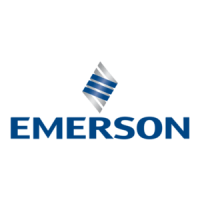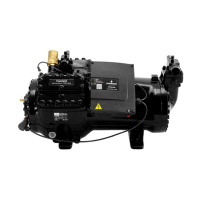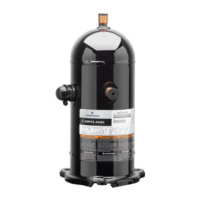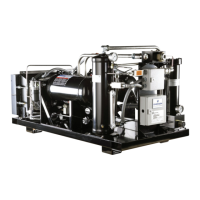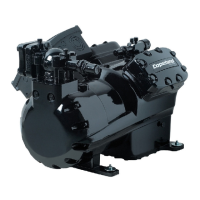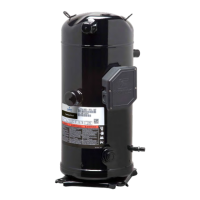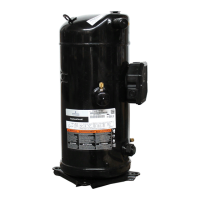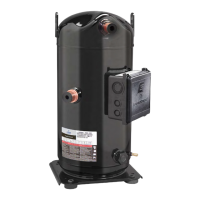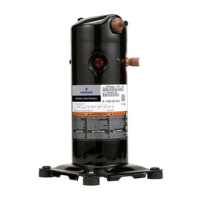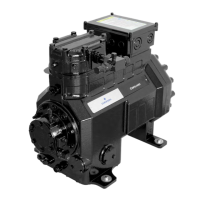
Do you have a question about the Emerson Copeland 2D and is the answer not in the manual?
| Category | Air Compressor |
|---|---|
| Power Source | Electric |
| Model | 2D |
| Refrigerant | R-22 |
| Voltage | 230V |
Overview of 2D*, 3D*, and 8D* compressor models and their displacement range.
Explanation of the model designation code and its technical information.
Details on crucial identification information printed on the compressor nameplate.
Covers qualified refrigerants, oils, and application limits for compressors.
Details on compressor construction, cooling, liquid injection, and capacity control.
Provides physical dimensions and port sizes for 2D*, 3D*, and 8D* compressor models.
Explanation of warning icons used in the manual for safety.
Critical statements regarding safe use, handling, and qualifications for personnel.
General warnings and precautions for system operation and handling.
Guidelines for receiving, transporting, and storing compressors safely.
Instructions for safely placing and securing compressors to prevent damage.
Details on using vibration dampers and mounting parts for compressor installation.
Requirements for high and low-pressure safety controls and their installation.
Recommended steps and safety precautions for brazing system components.
Advice on matching supply voltage, phases, and frequency to compressor specifications.
Procedures for safe electrical wiring, connections, and RCD installation.
Guidance on selecting and installing fuses for compressor electrical protection.
Information on factory-fitted motor protection devices like thermistors and Kriwan modules.
Details on the optional liquid injection system for extending application limits.
Explanation of oil pressure switches (OPS2) for compressor lubrication protection.
Importance and installation of crankcase heaters to prevent oil dilution.
Diagrams for direct-on-line, part-winding, and star/delta motor electrical connections.
Procedures for verifying system integrity and leak testing.
Requirements for vacuum pump down and moisture reduction for A2L systems.
Essential checks before initiating system start-up, especially for A2L systems.
Safe methods for charging the system with refrigerant, including precautions for A2L.
Critical steps and precautions for the first compressor start-up to avoid damage.
Importance of adequate run time for oil return and compressor longevity.
Guidance on operating compressors with variable frequency drives.
Safe methods for oil and refrigerant removal and disposal in compliance with regulations.
Specifies training and qualification requirements for personnel working on A2L systems.
Guidelines for planning and executing service tasks safely, including fire safety.
Safety precautions and procedures for removing brazed connections.
Steps for safely taking apart system components, including oil recovery.
Procedures for safely handling refrigerant exchange and contamination checks.
Steps for replacing a compressor, including oil handling and motor burnout issues.
Procedures for handling oil during maintenance, disposal, and chemical compatibility.
Detailed connection points, sizes, and part numbers for 2D* models.
Detailed connection points, sizes, and part numbers for 3D* models.
Detailed connection points, sizes, and part numbers for 8D* models.
Torque specifications for various components on 2D* and 3D* compressor models.
Torque specifications for various components on 8D* compressor models.
Torque values for magnetic plugs, cylinder heads, mounting feet, and terminal studs.
Common lubrication problems, causes, and symptoms like oil pump-out and low gas velocity.
Causes and prevention of oil dilution, including foaming and bearing failure.
Diagnosing and resolving issues related to low suction superheat causing component damage.
Causes and remedies for acid formation from moisture, oxygen, and high temperatures.
Identifying and addressing issues with compressor cooling leading to high discharge temperatures.
Symptoms and causes of excessive discharge temperatures, like dirty condensers.
How undersized contactors can lead to motor burnout despite protection systems.
Consequences of bypassing or disconnecting motor protection devices leading to burnout.
Information on publication scope, product modifications, and user responsibility for selection and use.
Disclaimer regarding liability for product specifications, errors, and warranties.
